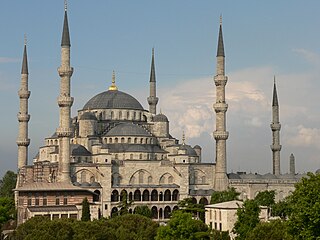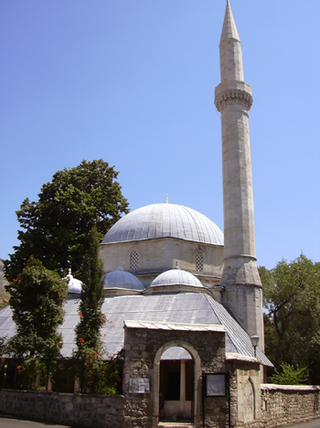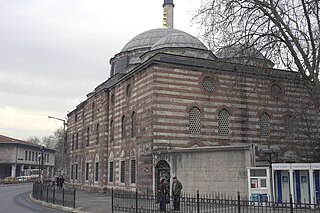
The Süleymaniye Mosque is an Ottoman imperial mosque located on the Third Hill of Istanbul, Turkey. The mosque was commissioned by Suleiman the Magnificent and designed by the imperial architect Mimar Sinan. An inscription specifies the foundation date as 1550 and the inauguration date as 1557, although work on the complex probably continued for a few years after this.

Mimar Sinan also known as Koca Mi'mâr Sinân Âğâ, was the chief Ottoman architect, engineer and mathematician for sultans Suleiman the Magnificent, Selim II and Murad III. He was responsible for the construction of more than 300 major structures, including the Selimiye Mosque in Edirne, the Kanuni Sultan Suleiman Bridge in Büyükçekmece, and the Mehmed Paša Sokolović Bridge in Višegrad, as well as other more modest projects such as madrasa's, külliyes, and bridges. His apprentices would later design the Sultan Ahmed Mosque in Istanbul and the Stari Most bridge in Mostar.

The Selimiye Mosque is an Ottoman imperial mosque, located in the city of Edirne, Turkey. It was commissioned by Sultan Selim II and was built by the imperial architect Mimar Sinan between 1568 and 1575. It was considered by Sinan to be his masterpiece and is one of the highest achievements of Islamic architecture as a whole and Ottoman architecture in particular.

Ottoman architecture is an architectural style or tradition that developed under the Ottoman Empire over a long period, undergoing some significant changes during its history. It first emerged in northwestern Anatolia in the late 13th century and developed from earlier Seljuk Turkish architecture, with influences from Byzantine and Iranian architecture along with other architectural traditions in the Middle East. Early Ottoman architecture experimented with multiple building types over the course of the 13th to 15th centuries, progressively evolving into the classical Ottoman style of the 16th and 17th centuries. This style was a mixture of native Turkish tradition and influences from the Hagia Sophia, resulting in monumental mosque buildings focused around a high central dome with a varying number of semi-domes. The most important architect of the classical period is Mimar Sinan, whose major works include the Şehzade Mosque, Süleymaniye Mosque, and Selimiye Mosque. The second half of the 16th century also saw the apogee of certain Ottoman decorative arts, most notably in the use of Iznik tiles.

Karađoz Bey Mosque is a 16th-century Ottoman mosque in the city of Mostar, Bosnia and Herzegovina.

The Şehzade Mosque is a 16th-century Ottoman imperial mosque located in the district of Fatih, on the third hill of Istanbul, Turkey. It was commissioned by Suleiman the Magnificent as a memorial to his son Şehzade Mehmed who died in 1543. It is sometimes referred to as the "Prince's Mosque" in English. The mosque was one of the earliest and most important works of architect Mimar Sinan and is one of the signature works of Classical Ottoman architecture.

The Mevlâna Museum, in Konya, Turkey, started life as the dervish lodge (Tekke) of the Mevlevi order, better known as the whirling dervishes. It houses the mausoleum of Jalal ad-Din Muhammad Rumi, a Persian Sufi mystic.

The Yavuz Selim Mosque, also known as the Selim I Mosque and the Yavuz Sultan Selim Mosque is a 16th-century Ottoman imperial mosque located at the top of the 5th hill of Istanbul, Turkey, in the neighborhood of Çukurbostan, overlooking the Golden Horn. Its size and geographic position make it a familiar landmark on the Istanbul skyline.

Sokollu Mehmed Pasha Mosque is a 16th-century Ottoman mosque in the Kadırga neighborhood in Fatih district, Istanbul, Turkey. It was commissioned jointly by the grand vizier Sokollu Mehmed Pasha and his wife İsmihan Sultan. It was designed by the imperial architect Mimar Sinan and completed in 1571/2. The mosque is noted for the fine quality of the Iznik tiles that decorate the interior walls.

The Atik Valide Mosque is a 16th century Ottoman imperial mosque located on a hill above the large and densely populated district of Üsküdar, in Istanbul, Turkey. It was built for Nurbanu Sultan, the wife of Sultan Selim II and formed part of a large complex that included a madrasa, guest-rooms and a double caravanseray. The mosque was designed by the imperial architect Mimar Sinan. Planning began in 1571 for a small mosque with a single minaret. The mosque was subsequently expanded and was not completed until 1586, three years after Nurbanu's death.

The Mihrimah Sultan Mosque is a 16th century Ottoman mosque overlooking the waterfront in the historic center of the Üsküdar district of Istanbul, Turkey. One of Üsküdar's best-known landmarks, it takes its alternative name from the ferry terminal near which it stands. Before the coast road was built, the mosque would have stood right beside the water, accessible by boat.

The Sinan Pasha Mosque is an Ottoman mosque located in a densely populated district of Beşiktaş, in Istanbul, Turkey. It was built by the Ottoman architect Mimar Sinan for the admiral Sinan Pasha. The türbe (tomb) of Barbaros Hayrettin Pasha is located just across the street.

The Zal Mahmud Pasha Mosque is a 16th-century Ottoman mosque located in the Eyüp district of Istanbul, Turkey. It was designed by the imperial architect Mimar Sinan and completed in 1590.

The Kara Ahmed Pasha Mosque or Gazi Ahmed Pasha Mosque is a 16th-century Ottoman mosque near the city walls in Istanbul, Turkey. It was designed by the imperial architect Mimar Sinan and completed in around 1572.

Sultan Mosque also called Hafsa Sultan Mosque is a 16th-century Ottoman mosque in Manisa, Turkey.

The Piyale Pasha Mosque, also known as the Tersane Mosque, is a 16th-century Ottoman mosque located in the Kasımpaşa neighborhood of the Beyoğlu district in Istanbul, Turkey.

The Hadim Ibrahim Pasha Mosque is a 16th-century Ottoman mosque located in the Silivrikapi neighborhood of Istanbul, Turkey.

The Haseki Sultan Complex is a 16th-century Ottoman imperial mosque complex in the Fatih district of Istanbul, Turkey. It was the first royal project designed by the chief imperial architect Mimar Sinan.

Classical Ottoman architecture is a period in Ottoman architecture generally including the 16th and 17th centuries. The period is most strongly associated with the works of Mimar Sinan, who was Chief Court Architect under three sultans between 1538 and 1588. The start of the period also coincided with the long reign of Suleiman the Magnificent, which is recognized as the apogee of Ottoman political and cultural development, with extensive patronage in art and architecture by the sultan, his family, and his high-ranking officials.
























